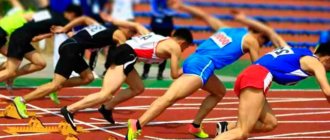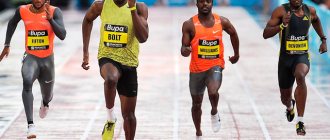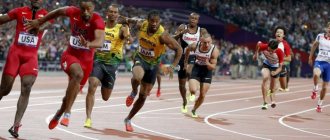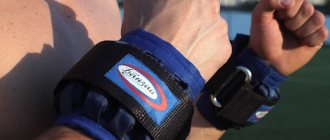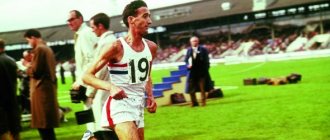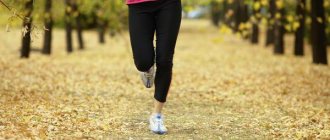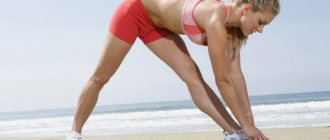Unlike a regular morning jog, long-distance running from 3 to 10 kilometers requires a competent approach. As with a marathon, long, regular training will be required.
And in order not to lead the body to overloads, injuries or sprains, you must first work on your long-distance running technique. You will learn its features, tactics for successfully completing the competition and basic tips in this article.
Long distance running technique
Long-distance running includes the popular 5 and 10 kilometer races, as well as 20, 25, 30 and 42 kilometres. Preparation for the race begins long before it starts. It is very important to create the right training program and strictly adhere to it to achieve the best results. The training will be based on the development of:
- speed;
- endurance;
- correct movements.
The technique of running over any distance includes the correct positioning of the arms, legs and body.
The technique of long-distance running includes the start, acceleration, main distance and finish.
At the start, the pushing leg is on the line, and the swing leg is behind. The torso is tilted forward, arms are bent at the elbows. The body straightens after the start gradually in the first 100 meters of the distance, when acceleration occurs. The main distance should be run at the same speed, allowing you to save energy for finishing. Acceleration towards the finish begins in the last 200-150 meters of the distance. As you accelerate, your torso tilt increases, your arms begin to work more actively, and your step width increases.
Straight running technique
ATTENTION! The most important indicators in training are efficiency of movements and power of effort. When running long distances, the athlete’s endurance and his ability to correctly distribute his strength come to the fore. The technique of running in a straight line includes the correct positioning of the arms, legs and body.
Hands
When running, your arms should be bent at the elbows at an angle of 90 degrees, your fists slightly clenched. To avoid cramps and waste of energy, the shoulders should be completely relaxed and the shoulder blades should be brought together.
Active arm work will help the athlete maintain and maintain optimal running speed. It is important to observe different movements of the arms and legs . When the right hand goes forward, the left leg goes forward and vice versa.
Legs
Footwork is a major focus in long-distance running. When running medium and long distances, toe running is used, since this is the method that allows you to push off strongly from the ground and maintain high speed. It is running from the toe that allows you to reduce the load on the ankle joint and avoid injury .
Quite often, runners use the toe-to-heel technique. It is this method that allows you to save energy and cover sufficient distances.
When pushing off the surface, you should direct your efforts to move forward, while the pushing leg is fully straightened. The more the knee of the swing leg is raised, the greater the speed the athlete can develop. The stride length when running long distances should be much shorter than when running short distances.
Frame
The body should not be tense; you should run freely and relaxed. The head should be placed straight, the neck muscles should not be tense. The tilt of the body is insignificant - 5 degrees forward. It is this position that can ensure maximum leg work.
Stage 3: train the body and spirit
To achieve good results, you need to give 100% in every workout. At the same time, there are no insignificant details - everything influences the result to one degree or another.
Therefore, athletes are advised to train their endurance in the gym or at home through strength exercises. It is also important to learn how to properly distribute your strength so as not to give up at the very end. Some athletes use this scheme: they divide the distance into two halves, and while they run the first part, they save energy for a jerk in the next.
But all this may not be enough to win. What else is missing? Psychological preparation. That is why it is recommended to give 100 percent in every workout, to jump above your head - thanks to this, you will develop the will to win, which will give you strength at the decisive moment.
High launch and acceleration in a straight line
A high start is ideal for non-professional runners, as it does not impair coordination and does not require specific skills, unlike a low start.
For a high start, the athlete places the starting foot on the block directly in front of the start line. The swing leg parallel to the push leg is placed behind the forefoot. As soon as the “Attention” command sounds, the weight of the entire body moves to the pushing leg.
Arms bent at the elbows are placed in front of the starting line. The hand opposite the pushing leg is slightly in front. The first few meters the body remains inclined, gradually straightening as it accelerates. During this distance the athlete reaches maximum running speed.
When accelerating in a straight line, there are two types:
- rolling out;
- power.
Rolling out
In this type of acceleration, acceleration is carried out using the foot and knee. The body is strongly tilted forward and the legs seem to catch up with the body.
This take-off run is good because it requires minimal effort and a fairly quick increase in speed.
Power
During power acceleration, the main load falls on the foot and back of the thigh. Therefore, with this type there is a possibility of damaging the thigh muscles. Power acceleration is used for short distances.
High launch and acceleration on turns
The tilt of the body during acceleration along a turn depends on the speed of the athlete and the radius of the turn. When accelerating, the body is tilted forward and directed along the turning arc. The feet are directed towards the side of the turn. The hand on the opposite side of the turn works much wider than the hand going along the turn.
After 20-30 meters, the body is completely straightened and running posture is restored.
Idea No. 5. Modern sports shoes can cause a lot of harm when running.
Sneakers seem to be an integral part of running, which at the same time raises many questions. After all, the Tarahumara ran ultramarathons in sandals made from car tires, and modern African tribes use thin shoes made from giraffe skin. McDougle tried to figure out which shoes are most suitable for running and how to avoid becoming a victim of modern marketing.
Our foot is an arch that performs its function only under load. Therefore, reducing the load on the foot, which occurs in soft sneakers, leads to muscle atrophy.
Sneakers that are too soft weaken the foot, leading to injury.
If you observe the natural behavior of the foot without shoes, you will see that the foot first lands on the outer edge, then slowly rolls from the little toe to the big toe. This movement provides natural shock absorption. And the sneaker blocks this movement.
To run, a person does not need springy sneakers, which weaken the feet and cause injuries. McDougle mentions an interesting fact - until 1972, Nike produced sports shoes that looked like slippers with thin soles. And at that time people received much less injuries.
In 2001, Nike also tracked a group of Stanford track and field athletes. Soon, marketers discovered that athletes preferred to run barefoot rather than wearing running shoes sent to them. The team's authoritative coach, Vina Lananna, explained this by the fact that without sneakers his athletes get fewer injuries. People haven't used shoes for thousands of years, and now shoe companies are trying to lock the foot tightly into a sneaker, which is fundamentally wrong.
In 2008, Dr. Craig Richards from the University of Australia began researching sneakers. He wondered whether shoe companies offered any guarantee that their products would reduce the risk of injury. It turned out not. Then the question becomes, what are we paying for when we buy expensive running shoes with air cushions, double cushioning and other unnecessary details. McDougle was also surprised by the fact that already in 1989, another study was conducted, which found that runners wearing expensive sneakers suffered more injuries than those who used cheaper options.
Another way to avoid injury is to not only use cheaper sneakers, but also not throw away your old ones. Scientists have found that wearing worn-out sneakers reduces the risk of injury. The fact is that over time the springy sole wears out and the athlete feels the surface better. This makes him run more carefully and attentively. The psychological aspect becomes decisive - the less confidence and stability we have, the more intelligently we perform the action and the more attentive we become.
In today's world, it's hard not to use shoes, especially in colder regions, but by arming yourself with knowledge about the athletic footwear industry, you can save money and reduce the risk of injury. McDougle recommends choosing lightweight, cheap running shoes that act as a sort of Tarahumara sandal.
Finishing technique
Finishing is the most emotional and important stage in long-distance running. The finishing technique is aimed at trying to preserve the maximum strength and speed of the athlete for the final throw.
At the finish line, running speed usually increases. The average length of the distance to increase speed is 200-300 meters, it all depends on the specific capabilities of the individual.
At the final stage of the distance, the athlete’s torso tilt increases and the activity of the arms increases. When finishing, the running gradually slows down, and the athlete gradually takes a step and stops.
Improving long-distance running technique
- Constant training. The ideal amount of training is 3-4 training sessions per week.
- Register your results. It is worth systematically recording your results to track dynamics.
- Interval training. For example, alternating jogging with sprinting.
- Long runs. Continuous running 1-2 times a month for an hour.
- Use exercise equipment to train muscles and increase endurance. An exercise bike is ideal for this purpose.
- Running faster. With each run, accelerate the last 200-300 meters before the finish.
ATTENTION! When jogging, do not forget about monitoring your physical condition. To do this, you should visit the clinic once a year for a routine medical examination and master methods of self-monitoring of your condition.
Where to run
You can run indoors on a treadmill or outdoors.
If you run outside, choose the optimal surface. Ideally, avoid asphalt, as the asphalt surface is very hard, which can lead to ankle injuries. If there is a stadium near you with a special surface and a running track, this is the best option. You can also run on the ground, it is softer, but by the end of the workout you will be covered with a layer of dust.
For me, I ran outside for the first two months and on the treadmill for the next two months.
It’s much easier to run on a treadmill after going outside - smooth surface, no slopes, no elevation changes, the track surface is soft compared to asphalt, plus additional functions such as heart rate monitoring, accurate distance measurement, and counting of calories burned. Plus, it’s cool in a ventilated room. In the summer I ran at temperatures of 27-32 degrees. Not very pleasant, I must say.


